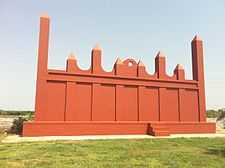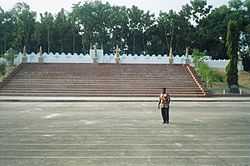Eidgah
Eidgah or Idgah (Urdu: عید گاہ) is the term used in south Asian Islamic culture for the open-air gathering place usually outside the city (or at the outskirts) to perform the Salat al Eid (Eid prayers) for Eid ul-Fitr and Eid al-Adha.[1] It is usually a public place that isn't used as a mosque at other times of the year.[2] At the end of the holy month of Ramadan, Muslims celebrate by first offering prayers at an Eidgah. It is a large open ground for people to assemble and offer their prayers early in the morning on the Eid day.[3][4] Although the term eidgah is of South Asian origin, Muslims around the world generally perform Eid prayers on similar pieces of open ground. [5]
It was a practice of Muhammad to perform the Eid salaah (prayer) in an open space on the outskirts of the city. Hence, it is considered a sunnah to perform Eid salaah at the Eidgah.[6] The very first Eidgah was at the outskirts of Medina nearly 1000 footsteps from Masjid al Nabawi.[7],[1]
Eidgah in Sharia
There are several guidelines for Eidgahs in Sharia.
- Complying to the Sunnah, performing of the Eid Salaah on the outskirts of the town is better and more virtuous, than performing it in the town.[8]
- The Eid Salaah performed in the Masjid is complete, but performing it in the Eidgah is Sunnah. Without any valid excuse, not to read the Eid Sunnah in the Eidgah is contrary to the Sunnah.[9]
- The Eid Salaah should be a huge gathering on the outskirts of the town. In this way the brotherhood of Islam is manifested. In the big cities it is difficult to make Eidgah on the outskirts of the city, therefore a huge open plain should be chosen for the Eidgah or according to the need, it can be performed in the Masjid, which will be correct. But as far as possible, one huge gathering is superior compared to many small Eidgahs.[10]
- Performing of the Eid Salaah in the Eidgah is Sunnat-e-Muak'kadah. Without any valid excuse, the one who does not perform his Eid Salaah in the Eidgah is worthy of being reprimanded and taken to task and this kind of a person is a sinner. If the Eidgah is a distance away and it is inconvenient for the old and sickly, then the Jurists have given permission for them to perform Eid Salaah in the Masjid.[11]
Eidgahs

Notable Eidgahs around the world include:
- Purani Idgah
- Idgah Mosque
- Shahi Eidgah
- Eidgah Kheri, Uttar Pradesh, India
- Eidgah Sharif, a Sunni Sufi Shrine located in Rawalpindi, Pakistan[12]
- Tumkur Eidgah
Eidgah Sharif
Eidgah Sharif is a Sunni Sufi shrine located in Rawalpindi, Pakistan. It was founded over a century ago and is host to many international visitors. Eidgah Shareef is also the frequent host of religious gatherings known as Milaad Paaks. A Milaad Paak is a series of presentations by scholars and by “reciters” who present religious material in solo a capella. At the largest of these, such as the Urs Paak more than 500,000 visitors crowd the grounds of Eidgah Shareef and spill over into the streets. About four million followers from all parts of Pakistan and about 50,000 more in the UK are sympathetic to this shrine. The shrine has a UK foundation named Mankind Welfare Trust.[12]
The custodian of Eidgah Shareef is Shaykh Hafiz Muhammad Naqib-Ur Rehman, known to his followers as “Pir Sa’ab”. The Shaykh advances the mission and teachings of Eidgah Shareef with the assistance of his son Sahibzada Muhammad Hassan Haseeb Ur Rehman, known to the devotees of Eidgah Shareef as “Sa’ab Ji”. Pir Sa’ab’s ancestors, the previous Custodians of Eidgah Shareef, were all Sufi Masters and linear descendants of the 15th century Mughal Emperor Babur. In about 1960, the family gave Pakistan a large proportion of the lands that were used to establish Pakistan’s planned capital city, Islamabad, located not far from Rawalpindi.[12]
Tukmur Eidgah
The Tumkur Eidgah, located approximately 70 kilometeres from Bangalore, is unique and combines traditional themes with the modern. Designed and built by Dr. Nazeer Ahmed, a space scientist, it has built into it subtleties that go beyond the ordinary. First, the divine name “Allah” is built into the structure, read right to left as is its reflection, read left to right. The reflection suggests the world is illusory and is only a reflection of the heavens. Secondly, each of the smaller minarets is nineteen feet from the ground. The number nineteen is a mystical number in Islam that appears in the Qur'an. The intermediate sized minarets are nineteen feet from the base. So, altogether there are six minarets that are nineteen feet each. Six times nineteen is 114, which is the total number of surahs in the Qur'an, a Book that completes God's favors upon humankind. Straight lines drawn from the apex of the minarets intersect where the word "Hu" is inscribed in a red circle. The subtended angle of 112.4 degrees is twice the natural flow angle of the earth into which we return. This flow angle is a solution to a Legendre polynomial of the second order which was presented in a paper by Dr. Ahmed at the fourth National Congress of Applied Mechanics at Harvard University, Cambridge, Mass. USA in 1972. "Hu" is the abstract divine pronoun for God, most exalted. The circle is a reminder of "two bows length or less" wrapped around that shrouded prophet Muhammed when he stood in divine presence during Me'raj. The entire structure is enclosed in a "golden rectangle" where the ratio of the width of the base to the height of the two large minarets is 1.618. The Eidgah complex accommodates 12,000 worshippers.
See also
- Eid ul-Fitr
- Eid al-Adha
References
| Wikimedia Commons has media related to Eidgah. |
- ↑ 1.0 1.1 Performance of Eid Salah in Eidgah (Open Field)
- ↑ "Special prayers in Idgah seeking divine blessings, eternal peace". The Hindu. Retrieved 9 February 2012.
- ↑ "Traffic curbs on Eid". Times of India. Retrieved 9 February 2012.
- ↑ "Traffic restrictions imposed for Eid prayers". Siasat Daily. Retrieved 9 February 2012.
- ↑
- ↑ Eidgah
- ↑ (Mariful Hadîth, Vol. 3, P.399)
- ↑ (Fatwa Darul Uloom, Vol 5, P. 208)
 This article incorporates text from this source, which is in the public domain.
This article incorporates text from this source, which is in the public domain. - ↑ (Fatwa Darul Uloom, Vol. 5, P.2261)
 This article incorporates text from this source, which is in the public domain.
This article incorporates text from this source, which is in the public domain. - ↑ (Ahsanul Fatwa, Vol. 4, P. 119)
 This article incorporates text from this source, which is in the public domain.
This article incorporates text from this source, which is in the public domain. - ↑ (Fatwa Rahimiyah, Vol. 1, P.276)
 This article incorporates text from this source, which is in the public domain.
This article incorporates text from this source, which is in the public domain. - ↑ 12.0 12.1 12.2 Biography of Pir Saab
| ||||||||||||
